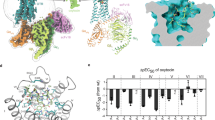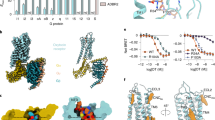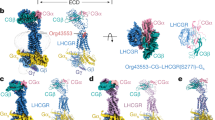Abstract
JUST before the onset of labour, uterine myometrium becomes extremely sensitive to oxytocin1 for which it is a primary target tissue, because of a dramatic increase in the number of oxytocin receptors2,3. We report here the structure and expression of the human oxytocin receptor complementary DNA isolated by expression cloning. The encoded receptor is a 388-amino-acidpolypeptide with7transmembrane domains typical of G protein-coupled receptors. The oxytocin receptor, expressed in Xenopus oocytes, specifically responds to oxytocin and induces an inward membrane current. Messenger RNAs for the receptor are of two sizes, 3.6 kilobases in breast, and 4.4 kilobases in ovary, uterine endometrium and myometrium. The mRNA level in the myometrium is very high at term. We conclude that the increase in receptor number in the myometrium at labour is, at least in part, due to the increase in mRNA.
This is a preview of subscription content, access via your institution
Access options
Subscribe to this journal
Receive 51 print issues and online access
$199.00 per year
only $3.90 per issue
Buy this article
- Purchase on Springer Link
- Instant access to full article PDF
Prices may be subject to local taxes which are calculated during checkout
Similar content being viewed by others
References
Cunningham F. G. MacDonald, P. C. & Gant, N. F. in Williams Obstetrics 18th (edn.) 187–226 (Appleton & Lange, Norwalk, Conneticut/San Mateo, California, 1989).
Soloff, M. S., Alexandrova, M. & Fernstrom, M. A. Science 204, 1313–1315 (1979).
Fuchs, A. R., Fuchs, F., Husslein, P. & Soloff, M. S. Am. J. Obstet. Gynec. 150, 734–741 (1984).
Sigel, E. J. Membrane Biol. 117, 201–221 (1990).
Kimura, T. et al. J. Steroid Biochem. molec Biol. (in the press).
Morley, S. D., Meyerhof, W., Schwarz, J. & Richter, D. J. molec. Endocr. 1, 77–81 (1988).
Hirono, C., Ito, I. & Sugiyama, H. J. Physiol., Lond. 382, 523–535 (1987).
Masu, Y. et al. Nature 329, 836–838 (1987).
Julius, D., MacDermott, A. B., Axel, R. & Jessell, T. M. Science 241, 558–564 (1988).
Masu, M., Tanabe, Y., Tsuchida, K., Shigemoto, R. & Nakanishi, S. Nature 349, 760–765 (1991).
Kozak, M. Nucleic Acids Res. 15, 8125–8148 (1987).
Kyte, J. & Doolittle, R. F. J. molec. Biol. 157, 105–132 (1982).
Hubbard, S. C. & Ivatt, R. J. A. Rev. Biochem. 50, 555–583 (1981).
Kennelly, P. J. & Krebs, E. G. J. biol. Chem. 266, 15555–15558 (1991).
Hugeuenin, R. L. Helv. chim. Acta 47, 1934–1941 (1964).
Bankowski, K., Manning, M., Seto, J., Haldar, J. & Sawyer, W. H. Int. J. Peptide Protein Res. 16, 382–391 (1980).
Fuchs, A. R. et al. Endocrinology 127, 629–636 (1990).
Sernia, C., Gemmell, R. T. & Thomas, W. G. J. Endocr. 121, 117–123 (1989).
Fuchs, A. R. et al. Am. J. Obstet. Gynecol. 163, 1961–1967 (1990).
Okayama, H. et al. Meth. Enzym. 154, 3–28 (1987).
Noma, Y. et al. Nature 319, 640–646 (1986).
Sanger, F., Nicklen, S. & Coulson, A. R. Proc. natn. Acad. Sci. U.S.A. 74, 5463–5467 (1977).
Peralta, E. G. et al. EMBO J. 6, 3923–3929 (1987).
Kobilka, B. K. et al. Proc natn. Acad. Sci. U.S.A. 84, 46–50 (1987).
Yokota, Y. et al. J. biol. Chem. 264, 17649–17652 (1989).
Hirata, M. et al. Nature 349, 617–620 (1991).
Nathans, J. & Hogness, D. S. Proc. natn. Acad. Sci. U.S.A. 81, 4851–4855 (1984).
Author information
Authors and Affiliations
Rights and permissions
About this article
Cite this article
Kimura, T., Tanizawa, O., Mori, K. et al. Structure and expression of a human oxytocin receptor. Nature 356, 526–529 (1992). https://doi.org/10.1038/356526a0
Received:
Accepted:
Issue Date:
DOI: https://doi.org/10.1038/356526a0
This article is cited by
-
Association of OXTR polymorphism (rs53576) with depression: a meta-analysis
Egyptian Journal of Medical Human Genetics (2023)
-
Endogenous oxytocin levels in children with autism: Associations with cortisol levels and oxytocin receptor gene methylation
Translational Psychiatry (2023)
-
Regulation of oxytocin receptor gene expression in obsessive–compulsive disorder: a possible role for the microbiota-host epigenetic axis
Clinical Epigenetics (2022)
-
Antenatal breastmilk expression for women with diabetes in pregnancy - a feasibility study
International Breastfeeding Journal (2021)
-
A randomized controlled trial of intranasal oxytocin in Phelan-McDermid syndrome
Molecular Autism (2021)
Comments
By submitting a comment you agree to abide by our Terms and Community Guidelines. If you find something abusive or that does not comply with our terms or guidelines please flag it as inappropriate.



